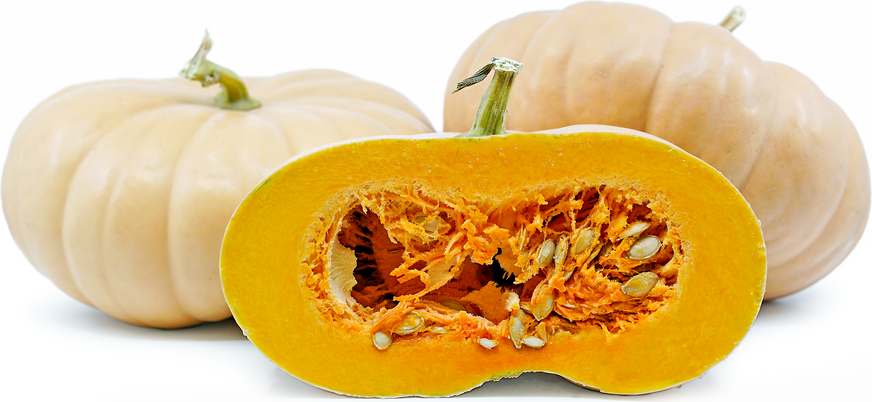


Long Island Cheese Squash
Estimated Inventory, lb : 0
Description/Taste
Long Island Cheese squash is medium to large in size, averaging 6-10 pounds in weight, and is round, squat, and semi-flattened in shape. The skin is tan to buff colored, smooth with slight vertical ribbing and is attached to a long and slender, thin, dry, and roughly texture green-brown stem at the cap. The flesh is orange, dense, fine-grained, and semi-brittle, surrounding a large, central cavity containing pulp and many flat, tear-drop shaped, cream-colored, edible seeds. When cooked, Long Island Cheese squash is tender and creamy with a mild, sweet, and earthy flavor.
Seasons/Availability
Long Island Cheese squash is available in the late fall through winter.
Current Facts
Long Island Cheese squash, botanically classified as Cucurbits moschata, is an heirloom variety with a rich American history and is a member of the Cucurbitaceae family along with gourds and pumpkins. Also known as the Long Island Cheese pumpkin, Long Island Cheese squash has been favored for its smooth texture, long storage capabilities, and for its use in pumpkin pie. Its name is a nod to the squash’s growing region along the eastern seaboard and also to its unique shape which resembles a cheese wheel. Long Island Cheese squash are in limited availability today due to the introduction of modern squash varieties and is listed on Slow Food’s Arc of Taste, which is a program designed to bring awareness and preservation to disappearing varieties.
Nutritional Value
Long Island Cheese squash is rich in beta-carotene, vitamin A, vitamin C, and potassium.
Applications
Long Island Cheese squash is best suited for cooked applications such as roasting, baking, sautéing, grilling, braising, frying, and boiling. It can be used when conventional pumpkin is called for, as a substitute for butternut squash, and can be cooked with or without the skin still attached. Once cooked, Long Island Cheese squash can be pureed and added to soups, sauces, preserves, and curries, or it can be added to desserts such as tarts, custards, cakes, bread, and the American classic, pumpkin pie. It can also be stuffed with meats, grains, and other winter vegetables and baked in the oven or battered and deep fried. Squash such as the Long Island Cheese has also been used in American craft beer brewing and can be added to mash prior to the fermentation of beer. Long Island Cheese squash pairs well with cheeses such as gruyere and parmesan, herbs and spices such as thyme, nutmeg, cinnamon, cloves, allspice, and ginger, meats such as poultry, sausage, turkey, and bacon, bread, onions, garlic, shallots, parsnips, leeks, fennel, corn, carrots, turnips, green apples, and heavy cream. This squash is an excellent keeper and can be stored in a cool, dry, dark place for 3-6 months.
Ethnic/Cultural Info
The Long Island Cheese squash is one of the oldest varieties of squash cultivated in the United States and was one of the first winter squashes to be domesticated for food and animal feed. Appearing in many American seed catalogs, cookbooks, and farmers almanacs dating back to the 1800’s, the squash is most well-known for its use in pumpkin pie and was favored for its adaptability to the eastern seaboard climate. It is also recommended as a healthy dietary addition for household pets, and when fed raw to chickens, it can help support healthy egg production in the winter months. Today, due to the decline of heirloom varieties, the Long Island Cheese pumpkin seeds are preserved in a regional seed bank on the east coast and is grown in the Smithsonian’s Victory Garden at the National Museum of American History.
Geography/History
The vine that produces the Long Island Cheese squash is believed to have originally been grown in Central or South America and made its way to North American gardens via explorers and traders. Officially introduced to the commercial marketplace in an 1807 seed catalog by Bernard McMahon of Philadelphia, the squash was a favored variety grown along the Atlantic seaboard throughout the 1800’s. It remained popular up until the 1960’s, but when new squash varieties were introduced to the market that was better suited for modern growing, harvesting, and distribution techniques for the canned pumpkin industry, the heirloom varieties began to disappear. In an effort to preserve the variety, the seeds of the Long Island Cheese squash were saved in the 1970s as part of the Long Island Seed Project. Today Long Island Cheese squash is available in limited quantities through farmers markets and specialty grocers, and the seeds can also be purchased for home gardens through online seed catalogs in the United States.
Recipe Ideas
Recipes that include Long Island Cheese Squash. One
| Out East Foodie |
|
Long Island Cheese Pumpkin Soup |




